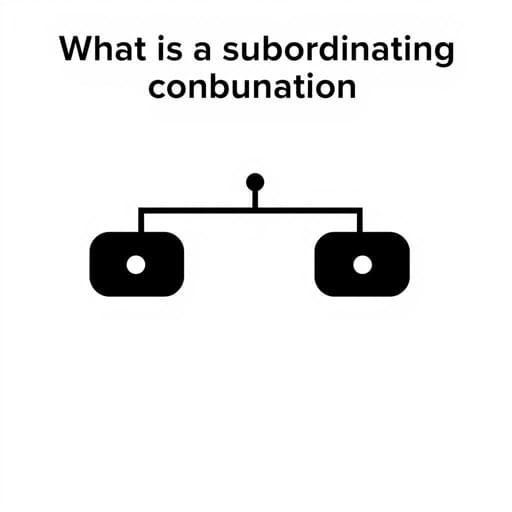What Is A Subordinating Conjunction
In English grammar, sentence structure plays a key role in clarity and meaning. To link ideas within a sentence, writers often use words called conjunctions. One important category is subordinating conjunctions. These small but powerful words help to join independent and dependent clauses, making the relationship between them clear. Understanding what a subordinating conjunction is and how it functions is essential for anyone aiming to write fluent, well-structured English sentences. Whether you’re composing essays, reports, or casual writing, mastering this element of grammar can significantly improve your communication skills.
Definition of a Subordinating Conjunction
A subordinating conjunction is a word or phrase that connects a dependent clause to an independent clause. It shows the relationship between the two clauses, such as time, cause and effect, contrast, or condition. Unlike coordinating conjunctions (like and, but, or or), subordinating conjunctions make one part of the sentence dependent on the other.
For example:Because it was raining, we stayed indoors. In this sentence, Because it was raining is the dependent clause, and we stayed indoors is the independent clause. The word because is the subordinating conjunction that links the two.
Common Subordinating Conjunctions
There are many subordinating conjunctions in English. Here are some of the most commonly used:
- Because
- Although
- Since
- If
- When
- While
- Unless
- After
- Before
- Even though
- As soon as
Each of these words sets up a relationship between the dependent clause and the main clause, helping the reader understand how the two parts of the sentence relate to each other.
Functions of Subordinating Conjunctions
Subordinating conjunctions serve various grammatical purposes. They introduce dependent clauses that can express different types of relationships:
Cause and Effect
These conjunctions show why something happened. Examples include:
- Because She was late because her car broke down.
- Since Since it’s snowing, school is canceled.
- As As I was tired, I went to bed early.
Time
These conjunctions indicate when something happens in relation to something else:
- After We went home after the movie ended.
- Before Finish your homework before dinner.
- When Call me when you arrive.
- While I listened to music while studying.
- As soon as Leave as soon as the meeting ends.
Contrast
These show a contrast or unexpected result:
- Although Although it was cold, she went swimming.
- Even though Even though he studied, he failed the test.
- Whereas He likes tea, whereas she prefers coffee.
Condition
These conjunctions express conditions that must be met:
- If If it rains, we’ll stay indoors.
- Unless You won’t pass unless you study.
- Provided that You can come provided that you’re quiet.
Structure of a Sentence with Subordinating Conjunctions
There are two main ways to structure a sentence with a subordinating conjunction:
- Dependent clause + comma + independent clause
- Independent clause + dependent clause (no comma needed)
Examples:
- Structure 1: Although he was tired, he kept working.
- Structure 2: He kept workingalthough he was tired.
The placement of the comma is important. When the dependent clause comes first, use a comma. When it comes after the main clause, usually no comma is needed.
Why Use Subordinating Conjunctions?
Using subordinating conjunctions adds depth and clarity to writing. They allow writers to combine ideas, express relationships between events or thoughts, and add complexity to sentence structure. Without them, writing can seem choppy or too simple.
For instance, instead of writing two short sentences like It was late. We didn’t go out, you can use a subordinating conjunction to write, Because it was late, we didn’t go out. This makes the relationship between the two ideas clearer and the writing more natural.
Subordinating Conjunctions vs. Relative Pronouns
It’s easy to confuse subordinating conjunctions with relative pronouns like who, that, or which. However, they have different roles. Relative pronouns introduce adjective clauses, which describe nouns. Subordinating conjunctions, on the other hand, introduce adverbial clauses, which describe verbs, adjectives, or other adverbs.
Example of a relative pronoun: The manwho lives next dooris a teacher.
Example of a subordinating conjunction:Because he lives next door, we often see him.
Practice and Examples
To gain confidence with subordinating conjunctions, try rewriting simple sentences by combining them with these conjunctions. Here are a few examples:
- He didn’t come. He was sick. â He didn’t comebecause he was sick.
- I’ll go to the store. You call me. â I’ll go to the storeafter you call me.
- The lights went out. We kept playing. âAlthough the lights went out, we kept playing.
Tips for Using Subordinating Conjunctions
- Choose the right conjunction based on the relationship you want to express.
- Watch out for word order remember that dependent clauses need an independent clause to complete the meaning.
- Use punctuation correctly, especially commas after introductory dependent clauses.
- Practice combining sentences using different subordinating conjunctions to vary sentence structure.
Subordinating conjunctions are essential tools in English grammar that help writers and speakers connect ideas smoothly and logically. By understanding how they function, what types exist, and how to use them correctly, anyone can elevate their writing. Whether you’re explaining reasons, showing contrast, or setting conditions, subordinating conjunctions provide the grammatical glue to hold your thoughts together clearly and cohesively. Mastering these small but mighty words will make your English writing more fluid, sophisticated, and engaging.
